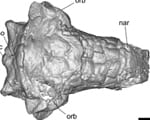The sinkholes are a little less than a mile apart, but that distance is closing as the land directly around both holes subsides about 2 inches each year.
New York Daily News journalist Anthony Izaguirre covered the research of SMU geophysicists Zhong Lu, professor, Shuler-Foscue Chair, and Jin-Woo Kim research scientist, both in the Roy M. Huffington Department of Earth Sciences at SMU. Izaguirre’s article, “Giant sinkholes in Texas are growing, may collide: study,” published June 16, 2016.
The Dedman College geophysicists are co-authors of a new analysis using satellite radar images to reveal ground movement of two giant sinkholes near Wink, Texas. They found that the movement suggests the two existing holes are expanding, and new ones are forming as nearby subsidence occurs at an alarming rate.
Lu is world-renowned for leading scientists in InSAR applications, short for a technique called interferometric synthetic aperture radar, to detect surface changes that aren’t visible to the naked eye. Lu is a member of the Science Definition Team for the dedicated U.S. and Indian NASA-ISRO InSAR mission, set for launch in 2020 to study hazards and global environmental change.
InSAR accesses a series of images captured by a read-out radar instrument mounted on the orbiting satellite Sentinel-1A. Sentinel-1A was launched in April 2014 as part of the European Union’s Copernicus program.
Lu and Kim reported the findings in the scientific journal Remote Sensing, in the article “Ongoing deformation of sinkholes in Wink, Texas, observed by time-series Sentinel-1A SAR Interferometry.”
The research was supported by the U.S. Geological Survey Land Remote Sensing Program, the NASA Earth Surface & Interior Program, and the Shuler-Foscue Endowment at Southern Methodist University.
EXCERPT:
By Anthony Izaguirre
New York Daily News
Two massive, rapidly expanding sinkholes in Texas are at risk of collapsing into each other and causing a “catastrophic” natural disaster, scientists warned.Geophysicists at Southern Methodist University found that the land around the gaping sinkholes between the west Texas towns of Wink and Kermit is deteriorating — which could end up either forming more holes or creating one giant sinkhole.
These sinkholes, which were caused by the area’s oil and gas extraction industries, are nothing new to Texas residents.
The first hole, Wink Sink #1, opened up in 1980 and is currently about as wide as a football field.
Wink Sink #2, the larger of the two holes, opened in 2002 and stretches for 900 feet at its widest point.
The sinkholes are a little less than a mile apart, but that distance is closing as the land directly around both holes subsides about 2 inches each year.
“This area is heavily populated with oil and gas production equipment and installations, hazardous liquid pipelines, as well as two communities,” Jin-Woo Kim, a coauthor of the report, said in a statement. “A collapse could be catastrophic.”
Follow SMU Research on Twitter, @smuresearch.
For more SMU research see www.smuresearch.com.
SMU is a nationally ranked private university in Dallas founded 100 years ago. Today, SMU enrolls nearly 11,000 students who benefit from the academic opportunities and international reach of seven degree-granting schools. For more information, www.smu.edu.
SMU has an uplink facility located on campus for live TV, radio, or online interviews. To speak with an SMU expert or book an SMU guest in the studio, call SMU News & Communications at 214-768-7650.


 To request an interview with Zhong Lu call SMU News and Communications at 214-768-7650 or email SMU News at
To request an interview with Zhong Lu call SMU News and Communications at 214-768-7650 or email SMU News at  To request an interview with Jin-woo Kim call SMU News and Communications at 214-768-7650 or email SMU News at
To request an interview with Jin-woo Kim call SMU News and Communications at 214-768-7650 or email SMU News at  Early armored dino from Texas lacked cousin’s club-tail weapon, but had a nose for danger
Early armored dino from Texas lacked cousin’s club-tail weapon, but had a nose for danger SMU physicists: CERN’s Large Hadron Collider is once again smashing protons, taking data
SMU physicists: CERN’s Large Hadron Collider is once again smashing protons, taking data Nearby massive star explosion 30 million years ago equaled brightness of 100 million suns
Nearby massive star explosion 30 million years ago equaled brightness of 100 million suns